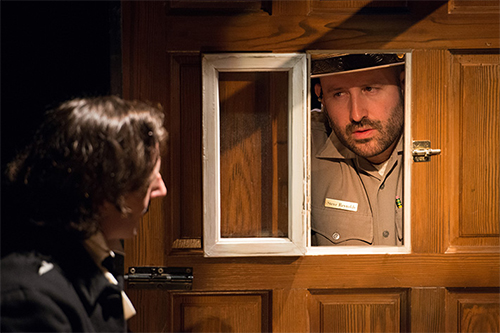Translate Page

The innovative design of "Red-Eye to Havre de Grace"
---
The man in the park ranger's uniform delivers something of an anti-curtain speech: "There is no nudity, strobe lights, smoking, or gunshots," he announces. Then, offhandedly, "But they do have this cool table that turns into a door and a bed that kinda flies around."
That's a basic (if oversimplified) explanation of "transformational scenography," the staging technique used to evoke the haunted and haunting world of Edgar Allan Poe during the final weeks of his life.
The show, Red-Eye to Havre de Grace, which is now at New York Theatre Workshop, is the latest work by Lucidity Suitcase Intercontinental, and the company has been devising it for over a decade. The play-with-music is arguably their most finely-honed production to date, crystallizing their distinct approach to design.
Eschewing elaborate sets and high-tech media, Lucidity Suitcase instead relies on a few simple objects that are used in myriad ways.
In Red-Eye to Havre de Grace, for instance, a table is used as a writing desk, then it becomes a train cabin after it's stood on its side and a window in the wood slides open. Later, a door becomes a series of hallways as an actor acrobatically strides across its surface while another tilts it from horizontal to vertical and back again. Next, the surface of a table becomes an entire paltry hotel room (not counting the space underneath, from which the spirit of Poe's dead wife pounds, Tell-Tale Heart-like, before reaching up and pulling him down into her lair).
For director/designer Thaddeus Phillips, these environments are much more powerful because they're merely suggested. "You have an active engagement in the audience's imagination, in the show, instead of spoon-feeding them media visually," he says.
However, this approach is about more than just getting our attention. "It's important that somehow the objects are reflected in the stories," says Jeremy Wilhelm, who co-created the show, plays several roles, and sings much of the score. "What's interesting about the way it evolved here is, yeah, [the table] is a writing desk. It's [Poe's] writing desk. There's stuff about interiors. There's all this stuff about [Poe's wife] dying in a bed. Metaphorically, it's tied in directly to the story."
As it shades and sculpts these objects, Drew Billiau's lighting design also conjures Poe's encroaching insanity. During a train journey, for instance, when the writer's mind is at the breaking point, bright beams of light rapidly dart across the stage, mapping the train's course while a pulsing soundscape throbs in the background. Later, Poe is forced to recite his famed poem The Raven, and with lights positioned in front of him on either side, his shadow spreads out, enormous and bat-like, on the back curtain.
The image echoes Poe's state of mind, which is soon apparent as his recitation goes off the rails and he spastically lurches around the stage.
By presenting Poe's visions as if they are reality, and by making his supposedly solid surroundings so malleable, Red-Eye helps us feel his insanity, as if we were trapped inside his head. Rather than simply telling us what madness is like, the production uses design to help us experience it ourselves.
For Phillips, this strikes at the heart of what theatre is for. "Some people sitting around a living room in a play gets real boring real fast," he says. And as Wilhelm notes, one of the primary ways that theatre communicates to its audience is through images. He cites the Greek term theatron, which literally means "the seeing place."
It makes sense, then, that Phillips focuses on "the kind of visual magic you can create."
---
Samantha Lazar is a Philadelphia-based dramaturg, designer, and arts critic
Photo by Johanna Austin